Does Deforestation Trigger Severe Flood Damage at Hoeryeong City in North Korea?
Abstract
1. Introduction
2. Materials and Methods
2.1. Study Area
2.2. Study Methods
2.2.1. Delineation of Flood-Damaged Areas and Build Database Establishment
2.2.2. Investigation of the Effects of Land-Use Change on Flooding
3. Results and Discussion
3.1. Geographic Properties of Land-Use Change Area
3.2. Spatial Correlation, Soil Loss, and Runoff Change
4. Conclusions
Author Contributions
Funding
Conflicts of Interest
References
- Lim, J.; Lee, K.S. Investigating flood susceptible areas in inaccessible regions using remote sensing and geographic information systems. Environ. Monit. Assess. 2017, 189, 96. [Google Scholar] [CrossRef] [PubMed]
- Lim, J.; Lee, K.S. Flood mapping using multi-source remotely sensed data and logistic regression in the heterogeneous mountainous regions in north korea. Remote. Sens. 2018, 10, 1036. [Google Scholar] [CrossRef]
- Kim, M.S. N. Korea Reeling from Flood Damage. Available online: http://english.chosun.com/site/data/html_dir/2016/09/19/2016091901010.html (accessed on 8 November 2016).
- Myeong, S.; Hong, H.; Choi, H.; Jeong, J. Estimation of Flood Vulnerable Areas in North Korea and Collaboration Strategies between South Kkorea and North Korea; Korea Environment Institute: Seoul, Korea, 2008; pp. 142–144. [Google Scholar]
- Myeong, S.J.; Kim, J.Y.; Lim, M.Y.; Hwang, S.H.; Son, G.W.; Ahn, J.H.; Gang, S.D.; Joo, G.S. A Study on Constructing a Cooperative System for South and North kKoreas to Counteract Climate Change on the Korean Peninsula III; Korea Environment Institute: Seoul, Korea, 2013; pp. 68–79. [Google Scholar]
- UNRCDPRK. Joint Assessment North Hamgyong Floods 2016; UN Resident Coordinator for DPR Korea: Pyeongyang, Korea, 2016; pp. 2–30. [Google Scholar]
- Lee, S.H. Situation of degraded forest land in dprk and strategies for forestry cooperation between south and north korea. J. Agric. Life Sci. 2004, 38, 101–113. [Google Scholar]
- Lee, M.B.; Kim, N.S.; Cho, Y.C.; Cha, J.Y. Landform and environment in border region of n. Korea and china. J. Korean Geogr. Soc. 2016, 51, 761–777. [Google Scholar]
- Lee, M.B.; Kim, N.S.; Lee, G.R.; Han, U. A study on the surface erosion by the development of cropland on the hillslope in the west coast area of north korea using quick bird satellite images. J. Korean Assoc. Reg. Geogr. 2005, 11, 453–462. [Google Scholar]
- Bradshaw, C.J.A.; Sodhi, N.S.; Peh, K.S.H.; Brook, B.W. Global evidence that deforestation amplifies flood risk and severity in the developing world. Glob. Chang. Biol. 2007, 13, 2379–2395. [Google Scholar] [CrossRef]
- Tan-Soo, J.-S.; Adnan, N.; Ahmad, I.; Pattanayak, S.K.; Vincent, J.R. Econometric evidence on forest ecosystem services: Deforestation and flooding in malaysia. Environ. Resour. Econ. 2016, 63, 25–44. [Google Scholar] [CrossRef]
- de la Paix, M.J.; Lanhai, L.; Xi, C.; Ahmed, S.; Varenyam, A. Soil degradation and altered flood risk as a consequence of deforestation. Land Degrad. Dev. 2013, 24, 478–485. [Google Scholar] [CrossRef]
- Lin, B.; Chen, X.; Yao, H.; Chen, Y.; Liu, M.; Gao, L.; James, A. Analyses of landuse change impacts on catchment runoff using different time indicators based on swat model. Ecol. Indic. 2015, 58, 55–63. [Google Scholar] [CrossRef]
- Ye, W.S.; Lee, H.S.; Lee, K.S. Application of the gis in the hydrologic effects caused by the second collective facility area development in mt. Kyeryong national park. J. Environ. Impact Assess. 1994, 3, 57–68. [Google Scholar]
- Guo, H.; Hu, Q.; Jiang, T. Annual and seasonal streamflow responses to climate and land-cover changes in the poyang lake basin, china. J. Hydrol. 2008, 355, 106–122. [Google Scholar] [CrossRef]
- Nirupama, N.; Simonovic, S.P. Increase of flood risk due to urbanisation: A canadian example. Nat. Hazards. 2006, 40, 25. [Google Scholar] [CrossRef]
- Ripley, B.D. Spatial Statistics; John Wiley & Sons: New York, NY, USA, 1981. [Google Scholar]
- Ripley, B.D. The second-order analysis of stationary point processes. J. Appl. Probab. 1976, 13, 255–266. [Google Scholar] [CrossRef]
- Spooner, P.G.; Lunt, I.D.; Okabe, A.; Shiode, S. Spatial analysis of roadside acacia populations on a road network using the network k-function. Landsc. Ecol. 2004, 19, 491–499. [Google Scholar] [CrossRef]
- Okabe, A.; Yamada, I. The k-function method on a network and its computational implementation. Geogr. Anal. 2001, 33, 271–290. [Google Scholar] [CrossRef]
- Yamada, I.; Thill, J.C. Comparison of planar and network k-functions in traffic accident analysis. J. Transp. Geogr. 2004, 12, 149–158. [Google Scholar] [CrossRef]
- Dai, D.; Taquechel, E.P.; Steward, J.; Strasser, S. The impact of built environment on pedestrian crashes and the identification of crash clusters on an urban university campus. West. J. Emerg. Med. 2010, 11, 294–301. [Google Scholar]
- Gunjal, K.; Goodbody, S.; Hollema, S.; Ghoos, K.; Wanmali, S.; Krishnamurthy, K.; Turano, E. Fao/Wfp Crop and Food Security Assessment Mission to the Democratic People’s Republic of Korea; Food and Agriculture Organization of the United Nations/World Food Programme: Rome, Italy, 2013; p. 11. [Google Scholar]
- Wikipedia. Hoeryong. Available online: https://en.wikipedia.org/wiki/Hoeryong (accessed on 8 March 2019).
- Wikipedia. North korea. Available online: https://en.wikipedia.org/wiki/North_Korea#Climate (accessed on 8 June 2016).
- Lee, M.B.; Kim, N.S.; Kang, C.S.; Shin, K.H.; Choe, H.S.; Han, U. Estimation of soil loss due to cropland increase in hoeryeung, northeast korea. J. Korean Assoc. Reg. Geogr. 2003, 9, 373–384. [Google Scholar]
- Jasiewicz, J.; Stepinski, T.F. Geomorphons—a pattern recognition approach to classification and mapping of landforms. Geomorphology 2013, 182, 147–156. [Google Scholar] [CrossRef]
- Jensen, J.R. Introductory Digital Image Processing: A Remote Sensing Perspective., 4th ed.; Pearson Education: Glenview, IL, USA, 2016. [Google Scholar]
- Wischmeier, W.H.; Smith, D.D. Predicting Rainfall Erosion Losses-A Guide to Conservation Planning; USDA, Science and Education Administration: Hyattsville, MD, USA, 1978. [Google Scholar]
- Morgan, R.; Davidson, D. Soil Erosion and Conservation; Longman Scientific & Technical co-published with John Wiley & Sons: Essex, UK; New York, NY, USA, 1986. [Google Scholar]
- Toxopeus, A.G. Ism: An Interactive Spatial and Temporal Modelling System as a Tool in Ecosystem Management; ITC: Kolkata, India, 1996. [Google Scholar]
- Lee, M.B.; Kim, N.S.; Jin, S.; Kim, H.D. A study on the soil erosion by landuse in the imjin river basin, dmz of cental korea. J. Korean Geogr. Soc. 2008, 43, 263–275. [Google Scholar]
- Ogawa, S.; Saito, G.; Mino, N.; Uchida, S.; Khan, N.M.; Shafiq, M. Estimation of Soil Erosion Using Usle and Landsat Tm in Pakistan. Available online: https://www.geospatialworld.net/article/estimation-of-soil-erosion-using-usle-and-landsat-tm-in-pakistan/ (accessed on 1 September 2009).
- Landphair, H.C.; Klatt, F. Landscape Architecture Construction, 2nd ed.; Elsevier: New York, NY, USA, 1988; pp. 112–122. [Google Scholar]
- Kim, J. A Study on Runoff Coefficient Estimation of Rational Method in the Korean River Basins. Ph.D. Thesis, Hongik University, Seoul, Korea, 2003. [Google Scholar]
- MOLIT. 1999 Report on the Development of Water Resources Management Techniques, Volume 1: Supplementary Appendix, Korea Probability Rainfall Rate; Ministry of Land, Infrastructure and Transport: Gwacheon, Korea, 2000; pp. 2–10. [Google Scholar]
- He, J.; Xu, J. Is there decentralization in north korea? Evidence and lessons from the sloping land management program 2004–2014. Land Use Policy 2017, 61, 113–125. [Google Scholar] [CrossRef]
- Shankman, D.; Liang, Q. Landscape changes and increasing flood frequency in china’s poyang lake region. Prof. Geogr. 2003, 55, 434–445. [Google Scholar] [CrossRef]
- Kwak, I.O. Spatial Structure and Function of Heoryong Market. Ph.D. Thesis, Korea University, Seoul, Korea, 2013. [Google Scholar]
- Xu, J.; van Noordwijk, M.; He, J.; Kim, K.-J.; Jo, R.-S.; Pak, K.-G.; Kye, U.-H.; Kim, J.-S.; Kim, K.-M.; Sim, Y.-N.; et al. Participatory agroforestry development for restoring degraded sloping land in dpr korea. Agrofor. Syst. 2012, 85, 291–303. [Google Scholar] [CrossRef]
- He, J.; Ho, M.H.; Xu, J. Participatory selection of tree species for agroforestry on sloping land in north korea. Mt. Res. Dev. 2015, 35, 318–327. [Google Scholar] [CrossRef]
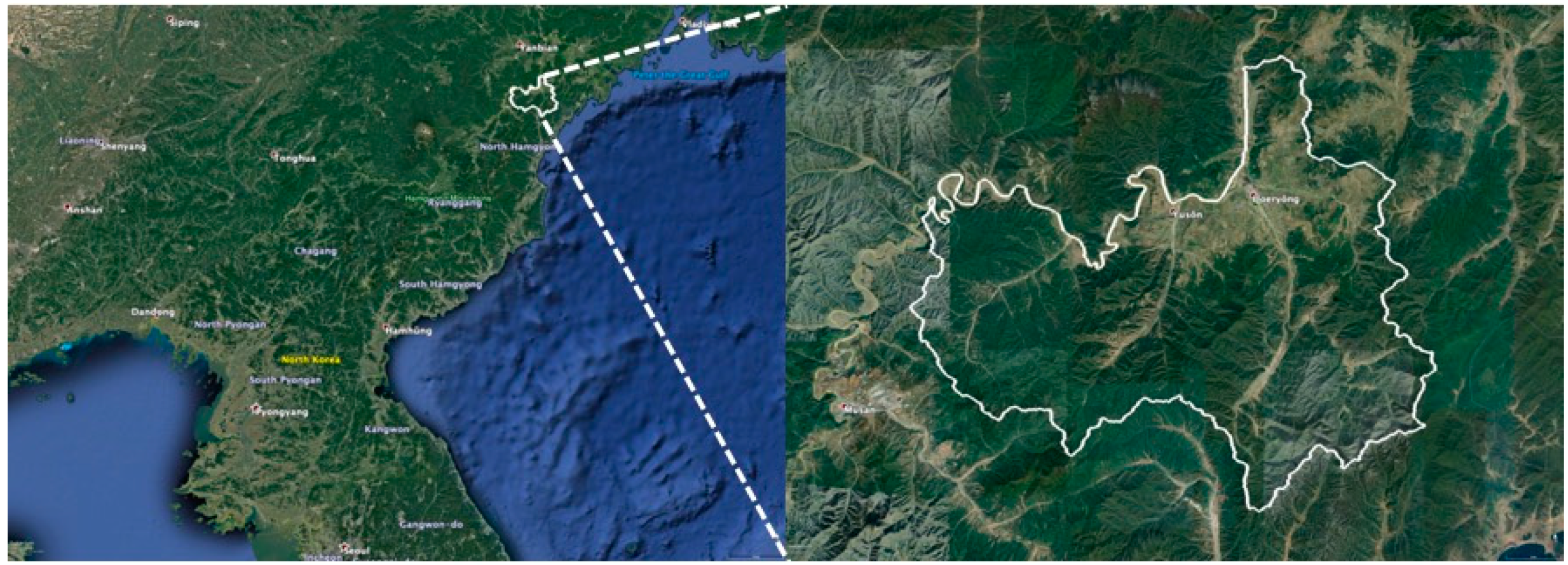
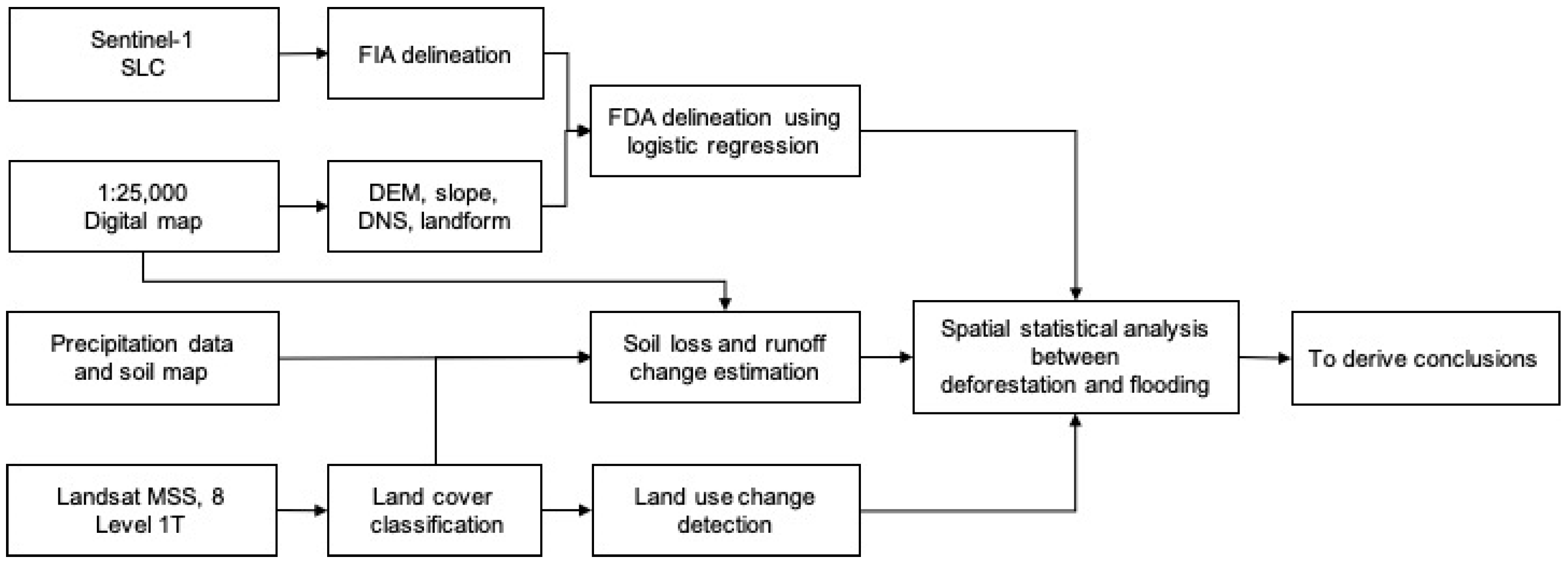
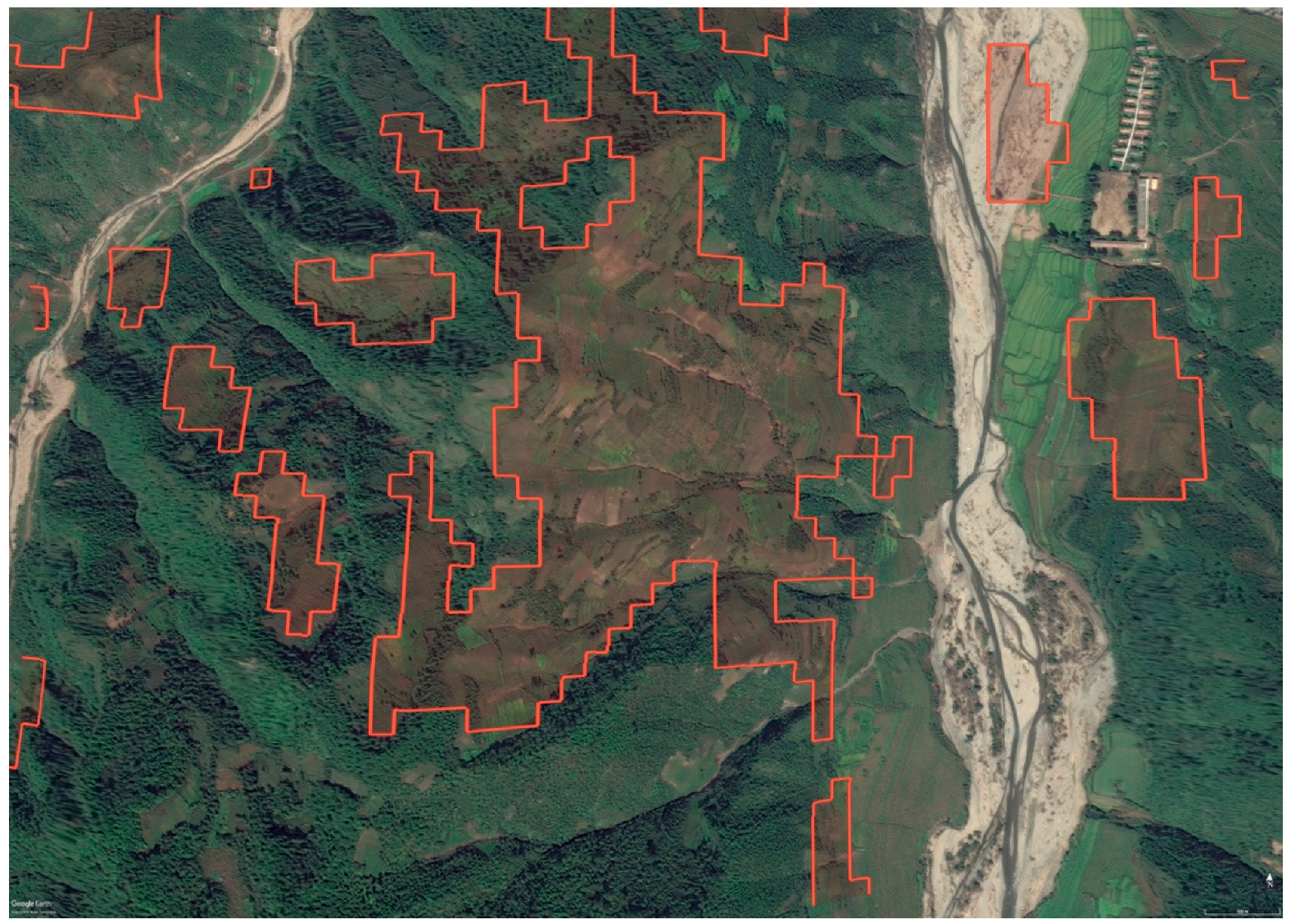
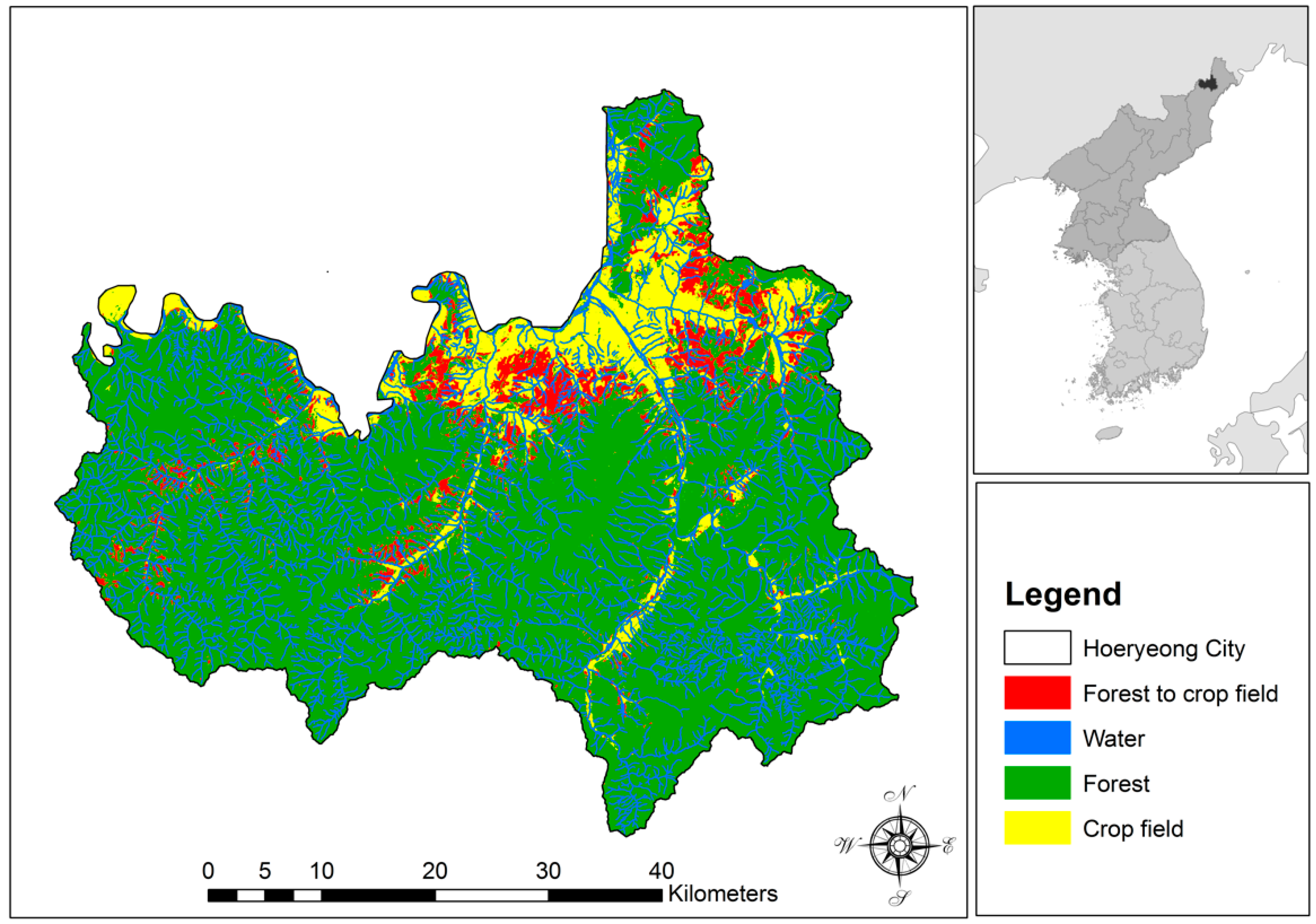
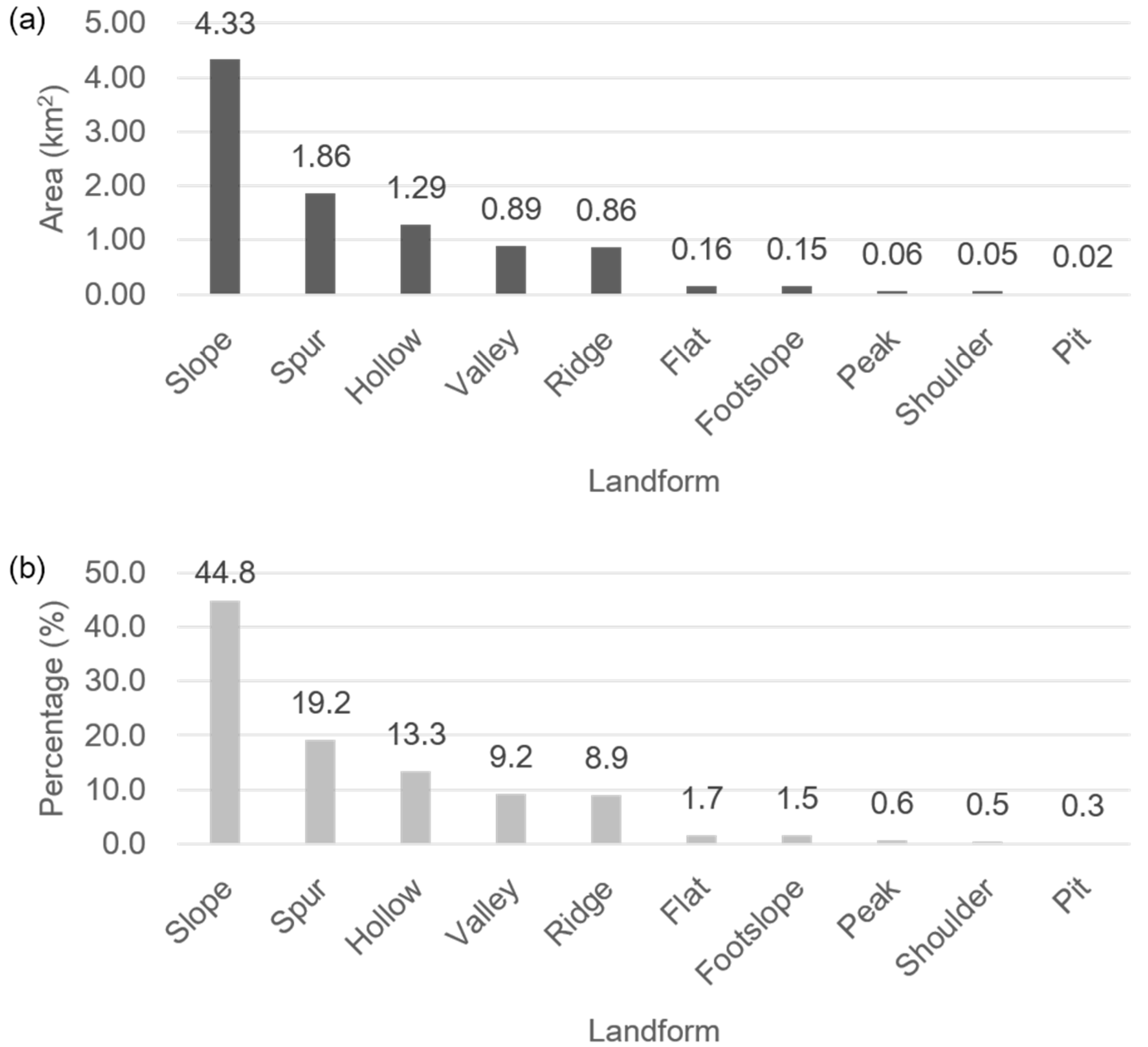
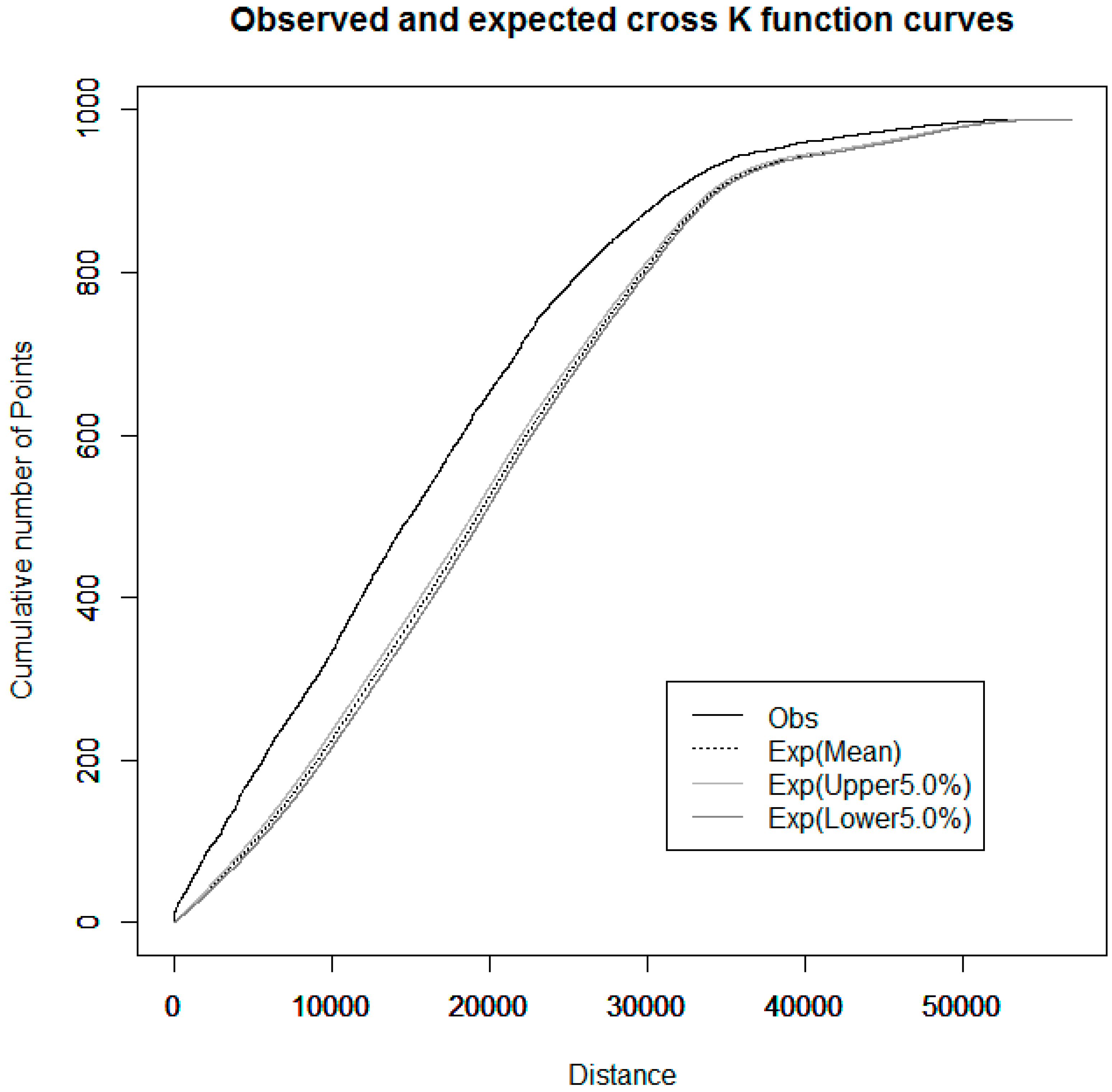
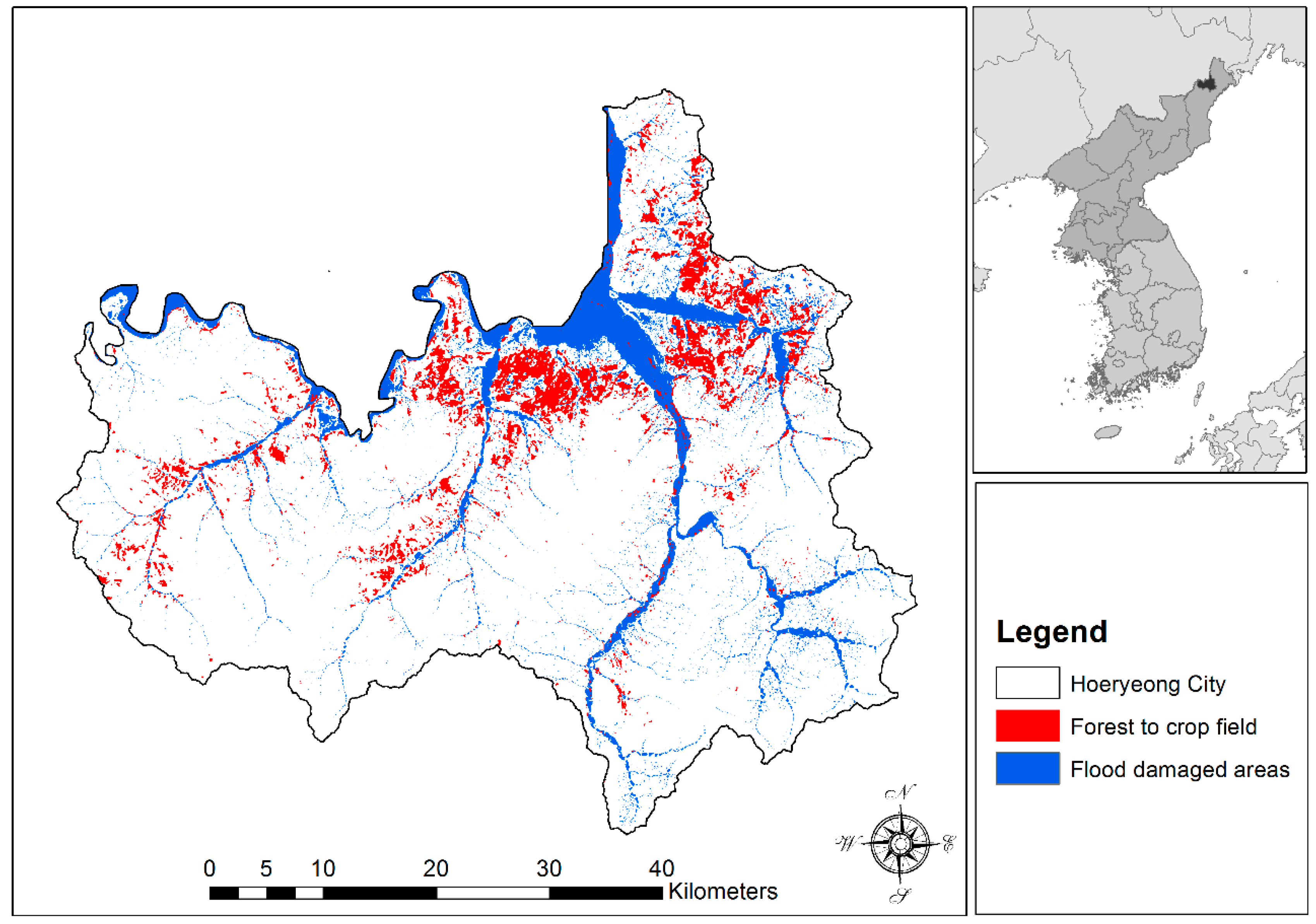
| Data | Period or Year | Spatial Resolution | Coordinate Projection | Level | Source | |
|---|---|---|---|---|---|---|
| RS | Landsat MSS | 1977.05.22 | 79 m | WGS84/UTM Zone 52N | 1T | USGS |
| Landsat 8 | 2016.05.28 | 30 m | ||||
| GIS | FDAs map | 2016 | 30 m | WGS84/UTM Zone 52N | Lim and Lee [2] | |
| Elevation map | 1:25,000 | WGS84/UTM Zone 52N | NGII Digital topographic data | |||
| Slope map | ||||||
| DNS map | ||||||
| Landform map | ||||||
| Annual mean precipitation data | 1977–2016 | Before 2011: 28.8 km grid (3/10-deg) After 2011: 19.2 km grid (1/5 deg) | WGS84 | NOAA | ||
| Soil data | 30 arc seconds | WGS84 | FAO |
| Grain Size Composition | Organic Matter Content (%) | ||
|---|---|---|---|
| Textural class | <0.5 | <2 | <4 |
| Sand | 0.05 | 0.03 | 0.02 |
| Fine sand | 0.16 | 0.14 | 0.10 |
| Very fine sand | 0.42 | 0.36 | 0.28 |
| Loamy sand | 0.12 | 0.10 | 0.08 |
| Loamy fine sand | 0.24 | 0.20 | 0.16 |
| Loamy very fine sand | 0.44 | 0.38 | 0.30 |
| Sandy loam | 0.27 | 0.24 | 0.19 |
| Fine sandy loam | 0.35 | 0.30 | 0.24 |
| Very fine sandy loam | 0.47 | 0.41 | 0.33 |
| Loam | 0.38 | 0.34 | 0.29 |
| Silty loam | 0.48 | 0.42 | 0.33 |
| Silt | 0.60 | 0.52 | 0.42 |
| Sandy clay loam | 0.27 | 0.25 | 0.21 |
| Clay loam | 0.28 | 0.25 | 0.21 |
| Silty clay loam | 0.37 | 0.32 | 0.26 |
| Sandy clay | 0.14 | 0.13 | 0.12 |
| Silty clay | 0.25 | 0.23 | 0.19 |
| Clay | 0.13–0.2 | ||
| Land Cover Type | C Value |
|---|---|
| Crop field | 0.4 |
| Forest | 0.1 |
| Water | 0 |
| Slope (%) | Contour Tillage | Contour Strip Tillage | Terraced Tillage |
|---|---|---|---|
| 1–2 | 0.60 | 0.30 | 0.12 |
| 3–8 | 0.50 | 0.25 | 0.10 |
| 9–12 | 0.60 | 0.30 | 0.12 |
| 13–16 | 0.70 | 0.35 | 0.14 |
| 17–20 | 0.80 | 0.40 | 0.16 |
| 21–25 | 0.90 | 0.45 | 0.18 |
| Runoff Coefficient | Rainfall Intensity (mm/hr) | Runoff (m3/sec) | |
|---|---|---|---|
| 1977 | 0.31 | 56.3 | 128.2 |
| 2016 | 0.46 | 60.8 | 206.6 |
| Difference | 0.15 | 4.4 | 78.4 |
© 2019 by the authors. Licensee MDPI, Basel, Switzerland. This article is an open access article distributed under the terms and conditions of the Creative Commons Attribution (CC BY) license (http://creativecommons.org/licenses/by/4.0/).
Share and Cite
Lim, J.; Kim, K.-M.; Lee, K.-S. Does Deforestation Trigger Severe Flood Damage at Hoeryeong City in North Korea? Forests 2019, 10, 789. https://doi.org/10.3390/f10090789
Lim J, Kim K-M, Lee K-S. Does Deforestation Trigger Severe Flood Damage at Hoeryeong City in North Korea? Forests. 2019; 10(9):789. https://doi.org/10.3390/f10090789
Chicago/Turabian StyleLim, Joongbin, Kyoung-Min Kim, and Kyoo-Seock Lee. 2019. "Does Deforestation Trigger Severe Flood Damage at Hoeryeong City in North Korea?" Forests 10, no. 9: 789. https://doi.org/10.3390/f10090789
APA StyleLim, J., Kim, K.-M., & Lee, K.-S. (2019). Does Deforestation Trigger Severe Flood Damage at Hoeryeong City in North Korea? Forests, 10(9), 789. https://doi.org/10.3390/f10090789





